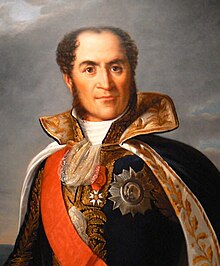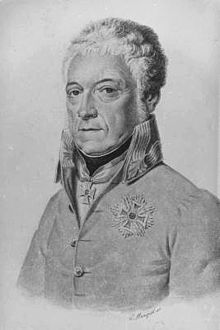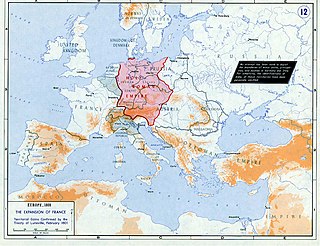
The Treaty of Lunéville was signed in the Treaty House of Lunéville on 9 February 1801. The signatory parties were the French Republic and Emperor Francis II, who signed on his own behalf as ruler of the hereditary domains of the House of Austria and on behalf of the Holy Roman Empire. The signatories were Joseph Bonaparte and Count Ludwig von Cobenzl, the Austrian foreign minister. The treaty formally ended Austrian and Imperial participation in the War of the Second Coalition and the French Revolutionary Wars, as well as the Imperial Kingdom of Italy.
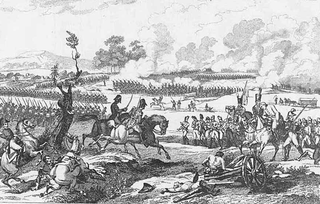
The Battle of Pozzolo also known as the Battle of the Mincio River and Monzambano was fought during the War of the Second Coalition. A French army under General Guillaume Brune crossed the Mincio River and defeated an Austrian force under General Heinrich von Bellegarde. The Austrians were subsequently pushed back to Treviso where the Armistice of Treviso was signed. This truce would lead to the Treaty of Lunéville and the withdrawal of Austria from the war.
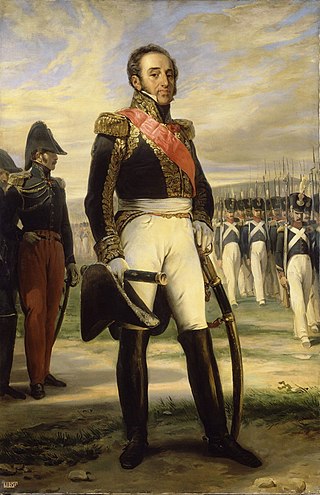
Louis-Gabriel Suchet, duc d'Albuféra, was a French Marshal of the Empire and one of the most successful commanders of the French Revolutionary and Napoleonic Wars. He is regarded as one of the greatest generals of the Napoleonic Wars.

The Hundred Days, also known as the War of the Seventh Coalition, marked the period between Napoleon's return from eleven months of exile on the island of Elba to Paris on 20 March 1815 and the second restoration of King Louis XVIII on 8 July 1815. This period saw the War of the Seventh Coalition, and includes the Waterloo Campaign and the Neapolitan War as well as several other minor campaigns. The phrase les Cent Jours was first used by the prefect of Paris, Gaspard, comte de Chabrol, in his speech welcoming the king back to Paris on 8 July.

The War of the Second Coalition was the second war targeting revolutionary France by many European monarchies, led by Britain, Austria, and Russia and including the Ottoman Empire, Portugal, Naples and various German monarchies. Prussia did not join the coalition, while Spain supported France.

The Italian campaigns of the French Revolutionary Wars (1792–1801) were a series of conflicts fought principally in Northern Italy between the French Revolutionary Army and a Coalition of Austria, Russia, Piedmont-Sardinia, and a number of other Italian states.

Johann Ludwig Joseph, Graf von Cobenzl was a diplomat and politician of the Habsburg monarchy.
The Réveillon riots between 26 and 29 April 1789 centered in the St. Antoine district of Paris where a factory which produced luxury wallpaper was owned by Jean-Baptiste Réveillon. The factory employed around 300 people. The factory where the riot took place was unusual in pre-revolutionary France as the factory was guild-free in an era where guilds controlled quality standards.
Baron Paul Davidovich or Pavle Davidović became a general of the Austrian Empire and a Knight of the Military Order of Maria Theresa. He played a major role in the 1796 Italian campaign during the French Revolutionary Wars, leading corps-sized commands in the fighting against the French army led by Napoleon Bonaparte. He led troops during the Napoleonic Wars and was Proprietor (Inhaber) of an Austrian infantry regiment.

The Treaty of Fontainebleau was an agreement concluded in Fontainebleau, France, on 11 April 1814 between Napoleon and representatives of Austria, Russia and Prussia. The treaty was signed in Paris on 11 April by the plenipotentiaries of both sides and ratified by Napoleon on 13 April. With this treaty, the allies ended Napoleon's rule as emperor of the French and sent him into exile on Elba.

Pierre Nicholas Dorsaz, was an inhabitant of the village of Bourg-Saint-Pierre who acted as Napoleon Bonaparte's guide when he crossed the Alps in 1800, by way of the Great St Bernard Pass, as part of his plan to make an unexpected arrival in Italy, and surprise the Austrian army.

Franz von Weyrother was an Austrian staff officer and general who fought during the French Revolutionary Wars and the Napoleonic Wars. He drew up the plans for the disastrous defeats at the Battle of Rivoli, Battle of Hohenlinden and the Battle of Austerlitz, in which the Austrian army was defeated by Napoleon Bonaparte twice and Jean Moreau once.
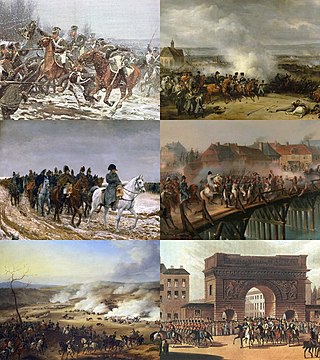
The 1814 campaign in north-east France was Napoleon's final campaign of the War of the Sixth Coalition. Following their victory at Leipzig in 1813, the Austrian, Prussian, Russian, and other German armies of the Sixth Coalition invaded France. Despite the disproportionate forces in favour of the Coalition, Napoleon managed to inflict several defeats, the Six Days' Campaign being the most well-known. However, the campaign ended in total defeat for Napoleon as the Coalition kept advancing towards Paris. Napoleon was out of position to defend the capital, which capitulated in late March 1814. When Napoleon proposed the army march on Paris, his Marshals decided to unanimously overrule Napoleon in order to save the city from further destruction. As a result, the victorious Coalition negotiated the Treaty of Paris, under which Napoleon was exiled to the island of Elba and the borders of France were returned to where they had been in 1792.

Baron Josef Philipp Vukassovich was a Croatian soldier who joined the army of Habsburg monarchy and fought against both Ottoman Empire and the First French Republic. During the French Revolutionary Wars, he commanded a brigade in the 1796–1797 Italian campaign against Napoleon Bonaparte. He led a division during the Napoleonic Wars and received a fatal wound in action.

The Allied sovereigns' visit to England occurred in June 1814 to celebrate the peace following the defeat of France and abdication of Napoleon Bonaparte in April 1814. The sovereigns and generals of the Coalition Allies – comprising Austria, Prussia, Russia, Sweden, the United Kingdom, and a number of German States – took part in a state visit and various peace celebrations in London before progressing to the Congress of Vienna later that year. It is also occasionally known as the Congress of London, although most diplomatic discussions were deferred until Vienna.

The Battle of Verona was fought on 18 October 1805 between the French Army of Italy under the command of André Masséna and an Austrian army led by Archduke Charles, Duke of Teschen. By the end of the day, Massena seized a bridgehead on the east bank of the Adige River, driving back the defending troops under Josef Philipp Vukassovich. The action took place near the city of Verona in northern Italy during the War of the Third Coalition, part of the Napoleonic Wars.
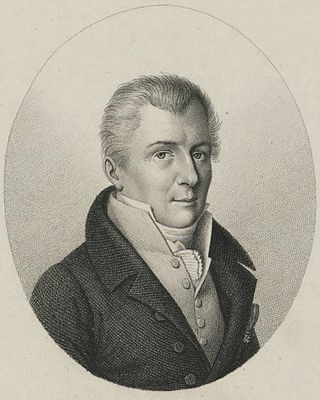
Emmerich Joseph Wolfgang Heribert de Dalberg, 1st Duke of Dalberg was a German diplomat who was elevated to the French nobility in the Napoleonic era and who held senior government positions during the Bourbon Restoration.

Sir Archibald Alison, 1st Baronet, was a Scottish advocate (attorney) and historian. He held several prominent legal appointments. He was the younger son of the Episcopalian cleric and author Archibald Alison. His elder brother was the physician and social reformer William Pulteney Alison.
The 1813 Treaty of Stockholm was a "treaty of concert and subsidy" between Great Britain and Sweden. It was signed on 3 March 1813 by Alexander Hope and Edward Thornton for Great Britain and by Lars von Engeström and Gustaf af Wetterstedt for Sweden. The treaty secured Swedish military cooperation against Napoleon. In return, Great Britain would support the destruction of Denmark-Norway by annexation of the Norwegian part and to pay subsidies to Sweden.

The Armistice of Steyr was a ceasefire agreement between the forces of the Holy Roman Empire and the French Republic that ended active hostilities in the War of the Second Coalition in Germany. It was signed on 25 December 1800 in the Austrian town of Steyr by Archduke Charles of Austria and the French commander, Jean Victor Moreau.
